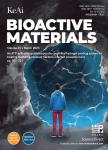版权所有:内蒙古大学图书馆 技术提供:维普资讯• 智图
内蒙古自治区呼和浩特市赛罕区大学西街235号 邮编: 010021

作者机构:Department of Chemical and Biomolecular EngineeringNational University of Singapore4 Engineering Drive 4117585Singapore School of Materials Science and EngineeringNanyang Technological University50 Nanyang Avenue639798Singapore
出 版 物:《Bioactive Materials》 (生物活性材料(英文))
年 卷 期:2021年第6卷第4期
页 面:941-950页
核心收录:
学科分类:07[理学] 070205[理学-凝聚态物理] 08[工学] 080501[工学-材料物理与化学] 0805[工学-材料科学与工程(可授工学、理学学位)] 0702[理学-物理学]
基 金:This work was financially supported by Ministry of Education Singapore under Grant R-279-000-580-112 and R-279-000-538-114
主 题:Gold nanoclusters Gold nanoparticles Antimicrobial agents Molecule-like properties Size effects
摘 要:The size of metal nanoparticles(NPs)is crucial in their biomedical *** abundant studies on the size effects of metal NPs in the range of 2-100 nm have been conducted,the exploration of the ultrasmall metal nanoclusters(NCs)of~1 nm in size with unique features is quite *** synthesize three different sized gold(Au)NCs of different Au atom numbers and two bigger sized Au NPs protected by the same ligand to study the size influence on antimicrobial *** ultrasmall Au NCs can easily traverse the cell wall pores to be internalized inside bacteria,inducing reactive oxygen species generation to oxidize bacterial membrane and disturb bacterial *** explains why the Au NCs are antimicrobial while the Au NPs are non-antimicrobial,suggesting the key role of size in antimicrobial ***,in contrast to the widely known size-dependent antimicrobial properties,the Au NCs of different atom numbers demonstrate molecule-like instead of size-dependent antimicrobial behavior with comparable effectiveness,indicating the unique molecule-like feature of ultrasmall Au *** the bacterial defenses at the wall with ultrasmall Au NCs changes what was previously believed to harmless to the bacteria instead to a highly potent agent against the bacteria.